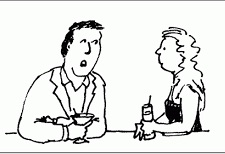I spent the last 15 months writing for a real estate investment company. It was a decent gig – sort of rewarding sometimes, and astoundingly frustrating at others. But my time there reminded me of the difference in writing for someone else’s byline and writing under your own.
When I was reporting, I had editors and a copydesk checking me over, but it was my byline and fundamentally my words. I had a say in how they were presented and while I might lose arguments, my opinion was at least considered because it had my byline – my name – on it. But when you’re writing anonymously, that’s a bit of pride you simply aren’t allowed. It took me a long time to realize that, to get past my own arrogance and understand that I had put a price on my words when I took the paycheck. As Don Draper said, “that’s what the money is for.”
I’m not sure it’s a sustainable tradeoff, though.
Don’t get me wrong, I was grateful for the income. I liked most of the people I worked with. But the thing I love most in this world is words. I love coming up with a phrase, a sentence that maybe no one has ever come up with before. The idea that what I have created is simply mine, from my brain, out of my fingers.
That is not the case when you are writing for other people. And writing for money. That can be painful sometimes, because as a writer you write the way you think it should be written. You give it your best shot. But when you are writing for other people’s money, you turn your version over to their viewpoint. The way they think it should sound, it should flow. You have to subserviate your best judgement to theirs.
Man, is that hard. Even when you think it’s not going to be hard. Even when you’re getting paid to write and then let them mold it, let them change it. In some cases let then RUIN it, it’s just hard to do day in and day out. Eventually you either start to resent it or you die. You can suppress it for a while – you can make yourself think it doesn’t matter, that it’s not your name on the page, that no one will ever know it was actually you who wrote it. No one but you, that is.
The best-case scenario, of course, is that the person who is paying you to write appreciates your talent and your skill and respects the way you created in the first place. But you can’t go into a paid gig expecting that reaction, because they have their own ideas and their own vision of the piece in their heads, too. And fundamentally, they have more consequence for the piece than you do. You have to defer. It’s part of the deal.
But don’t kid yourself into thinking it’s perpetually easy. ‘Cause it ain’t.

